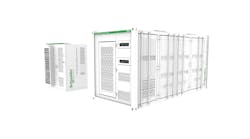In this Q&A with Microgrid Knowledge, Bob Georgeoff, vice president of Ameresco, explains the implications for microgrids of recent public safety power shutoffs in California.
Bob Georgeoff, vice president, Ameresco
Microgrid Knowledge: What role can microgrids play when there is a Public Safety Power Shutoff (PSPS) in California?
Bob Georgeoff: Microgrids play a critical role. When a utility makes the choice to enact public safety power shutoffs, a microgrid keeps organizations up and running productively during the outage. While interconnected with the electric grid during normal conditions, microgrids can be designed to operate in island mode which seamlessly disconnect from the grid during power outages while keeping the power on. This capability can power shelters for the local community, prevent loss of business revenue, and enable local governments or hospitals to provide emergency services when the surrounding areas are without power.
MGK: Who — what kind of industry or institution — most needs a microgrid when these shutoffs occur?
BG: Any institution concerned about reliable utility supply can benefit from a microgrid. Facilities that provide emergency services are top candidates for microgrids — local government, fire departments, community shelters, and hospitals for example. Additionally, office buildings can leverage a microgrid to continue with normal business operations and manufacturing facilities can benefit from avoiding interruption of production. There is also great value for scientific or medical research facilities when interruption of expensive or valuable research and experiments can be totally avoided in the event of a shutoff.
Cost quickly becomes neutralized when organizations consider the benefits that a microgrid can provide to their business or community — the value of power when “off” is not an option.
MGK: Any kind of electrical equipment can spark a fire, but some equipment is less likely to do so. What makes a microgrid a safer bet than grid power during wildfire season?
BG: The recent string of wildfires are understood to be caused by power lines in close proximity to trees and brush. Microgrid infrastructure delivers safe and reliable power when designed and installed by a reputable company in accordance with modern codes and standards. It provides power to a facility without needing to transport that power along aging infrastructure in close proximity to wilderness areas. The distributed nature of a microgrid, locating generation on-site, closer to your load requirements, enables the load to be sectionalized in times of crisis while still providing power.
MGK: How quickly can a microgrid be installed?
BG: Development and installation timelines of a microgrid vary depending upon the scope of the project and the existing electrical infrastructure of the facility. Timelines could range from a small, simple project taking a few months up to a large facility or campus with complicated infrastructure, interconnections, and permitting requirements taking more than a year to complete. Forethought to the value of resiliency during future PSPSs and volatile energy supply can guide organizations on how to get started with microgrids in the timeliest manner.
MGK: There is a lot of acknowledgement that California needs more microgrids. But what about the cost? How expensive are microgrids?
BG: Specific costs for integrating a microgrid into an energy portfolio will vary with scope and project goals. The technology could be a small cost adder to a solar plus storage project or a multi-million-dollar endeavor for a large campus of buildings. Most importantly, it is critical to take a holistic approach. This empowers organizations to make the most cost-effective investment. First, we evaluate energy efficiency measures to right-size a microgrid’s required capacity. Then we consider what on-site generation is needed to ensure critical loads can be met. We also like to examine additional value streams to make a project more affordable, such as using the microgrid to control and shift peak billing demand to reduce electric costs. Cost quickly becomes neutralized when organizations consider the benefits that a microgrid can provide to their business or community — the value of power when “off” is not an option.
Bob Georgeoff is vice president of Ameresco.







